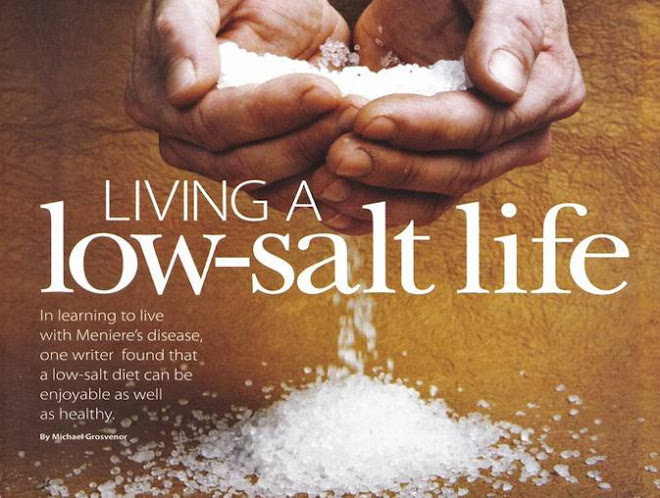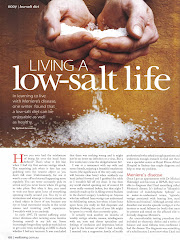So why does low-salt living work well for Meniere’s sufferers? Sodium, which is a primary component of salt (also known as sodium chloride), increases fluid retention in the body. The build-up of the potassium rich inner ear fluid I mentioned earlier can be alleviated by reducing overall fluid in the body and therefore lowering sodium levels, which in turn reduces the amount of fluid in the inner ear. Diuretics are also prescribed to further reduce bodily fluids.
It’s not only Meniere’s sufferers who benefit from lower salt levels in their diet. Those with high blood pressure will particularly benefit, with research also showing that a low-salt diet reduces the incidence of strokes, heart failure, kidney problems, gastric cancer, migraine headaches and osteoporosis. In fact, Australia’s high incidence of these particular health problems has resulted in a major campaign by Health Departments to lower people’s salt reduction because people consume way too much salt than necessary to maintain good health.
The National Health and Medical Research Centre suggests that the average Australian consumes 8 to 9 times more salt than necessary. They suggest that the recommended daily intake should be around 1,600 milligrams of sodium (or 4 grams or 1 teaspoon of salt). For Meniere’s sufferers, it is recommended that you go much lower than this. How much lower you go is the trial and error you will go through to find what works best for you.
I decided after months of experimenting with different levels that I should only eat low salt food which would ensure I stayed well under 800 milligrams per day. A low salt product is defined as any item that has a sodium component under 120 milligrams per 100 grams of weight. Thankfully, Australia’s advanced food labelling system has helped me enormously – every packaged food product has a nutritional information label, which includes the amount of sodium in each product.
And there is no need to worry about not having enough sodium in your body as there is enough sodium even in naturally low-salt foods to sustain healthy levels. I should know – I’ve been on a strict low salt diet for 12 years and through regular blood and urine testing I can safely say that I have had no major repercussions from doing so.
Because of the fluid reduction, low-salt eaters should drink plenty of water every day to maintain good levels of hydration. This can be important as dehydration has led me to have some uncomfortable dizzy spells – this is one reason why alcohol and caffeine, which can dehydrate, can be problematic for Meniere’s suffers. And to continue to monitor your body’s health through regular testing with your local GP.
Once you get started on a low-salt diet you won’t want to turn back. There are two main reasons for this:
• You’ll start tasting the natural flavours of food once again and begin to recoil from food that is heavily salted – your palate just won’t accept these foods anymore.
• You’ll notice that you begin to eat much more healthily and your body feels so much better. It doesn’t take long for you to realise that many of the salty foods you have started cutting out are also high in fats.
So, what does a well balanced, healthy, yet very low salt diet look like? It took me a long while to figure it out because initially I was so focussed on sodium content that I forgot about the importance of nutrition. I became quite addicted to sweet foods and dairy products because they were relatively low in sodium. Unfortunately, this meant my body was being starved of protein whilst stocking up on fats and carbohydrates. It became obvious after a while why I started to put on some weight even though I was doing some exercise. My cholesterol also started to skyrocket during this time, although I later found out that this has as much to do with my family history. Over time I began to balance my body’s needs and developed a diet that is very low in salt, low in saturated fats and high in protein. Some people might also find it helpful to consult with a dietitican who can assist you to organise a healthy low salt diet that best works for you.
In an average eating day in my life, I can get down to as low as approximately 550 mg of sodium per day. This will be slightly higher or lower depending on what I have for dinner – the other meals remain fairly constant during the week. The protein component is gained from having servings of tinned salmon, nuts and chicken and every meal is low in saturated fat. My sweet tooth is satisfied by some small glasses of freshly squeezed home-made juice, which is much lower in sugar content than soft drinks. I also drink several litres of water per day.
This blog will begin posting low-salt recipe ideas that will ensure you can live a healthy and tasty low-salt life!
Monday, September 28, 2009
How to Live a Low-Salt Life
Labels:
food labels,
low salt,
low sodium,
low-salt,
low-salt food,
low-sodium,
meniere's disease
Subscribe to:
Post Comments (Atom)



No comments:
Post a Comment